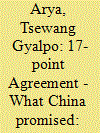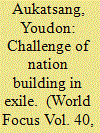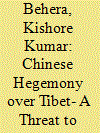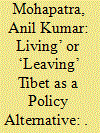|
|
|
Sort Order |
|
|
|
Items / Page
|
|
|
|
|
|
|
| Srl | Item |
| 1 |
ID:
166820


|
|
|
|
|
| Summary/Abstract |
From the historical perspective, despite the China’s claim that Tibet has been a part of China since ancient time1, irrefutable facts abound to demonstrate that Tibet has never been a part of China anywhere in its pre-1949 history2. It is only after the formation of People’s Republic of China (PRC), that China began to assert sovereignty over Tibet. The Communist China has tried to claim Tibet as a part of China under various unsubstantiated grounds. But like most of its concocted propaganda, the nature of their claims kept changing. First, they claimed Tibet as a part of China since 7th century Tibetan Emperor Srongtsan Gampo [Tib: Srong btsan sgampo], when the Tang Princess Wencheng Kungchu became one of the queens of Tibet.
|
|
|
|
|
|
|
|
|
|
|
|
|
|
|
|
| 2 |
ID:
166811


|
|
|
|
|
| Summary/Abstract |
When over 80,000 Tibetans fled Chinese occupation and followed His Holiness (HH) the Dalai Lama to India in 1959, none of them had any premonition of the duration of their stay in India. They endured the hardships in exile with a strong aspiration to return to Tibet soon.
|
|
|
|
|
|
|
|
|
|
|
|
|
|
|
|
| 3 |
ID:
166818


|
|
|
|
|
| Summary/Abstract |
According to the China’s State Council, after founding Tibet Autonomous Region in 1965, ecological improvement and environmental protection were included in government agenda. In 1975, the ‘Leading Group for Environmental Protection of TAR’ and its General Office were established. In 1983, the ‘Urban and Rural Construction and Environmental Protection Department’ under the government of the TAR was established.
|
|
|
|
|
|
|
|
|
|
|
|
|
|
|
|
| 4 |
ID:
166827


|
|
|
|
|
| Summary/Abstract |
Tibet is one of the most important bilateral issues bedeviling the relations between India and China. It is also one of the weakest links in China’s domestic policy. Tibet has enjoyed sovereignty for long spells in history. The Tibetans have a distinctive cultural identity which is fundamentally different from that of the Hans who constitute the overwhelming majority of the Chinese population.
|
|
|
|
|
|
|
|
|
|
|
|
|
|
|
|
| 5 |
ID:
166821


|
|
|
|
|
| Summary/Abstract |
When I was about six years old, my father bought me a pair of cheap Chinese canvas shoes. Sporting the new footwear, one day I climbed up to the rooftop of our house where grandpa usually sat sunbathing. As soon as I sat on the floor near him, he looked at my feet and said, ‘Wearing those thieves’ shoes again!’ I will never forget the expression of bitterness, scorn and disgust on his hardened face.
|
|
|
|
|
|
|
|
|
|
|
|
|
|
|
|
| 6 |
ID:
166815


|
|
|
|
|
| Summary/Abstract |
In the current international system, both countries are seen to be cooperating on a variety of issues and across a number of platforms. These include participation in both interregional and bilateral cooperation. Along with other emerging economies of the world, India and China are a part of the BRICS, which also incorporates Brazil, Russia and South Africa. This multilateral conglomeration focuses on the promotion of trade and industry in their respective nations that has also led to the creation of a BRICS Development bank.
|
|
|
|
|
|
|
|
|
|
|
|
|
|
|
|
| 7 |
ID:
166824


|
|
|
|
|
| Summary/Abstract |
Ever since China came into existence it has made consistent efforts towards slowly and gradually integrating the regions which had potentials to go independent or cede from its mainland government like Tibet, Xinjiang, Hong Kong, Mongolia, and Taiwan. It is endeavouring aggressively to establish its hegemony over the whole of South China Sea. Consequently, it has built as well as building a network of roadways, railways, and airways as per the suitability of the region to integrate with its Han dominated country. According to many experts India’s stand on Tibet Autonomous Region was one of the dominant causes that led to Chinese attack on India, alongside China’s claims in the Aksai Chin and Arunachal Pradesh.
|
|
|
|
|
|
|
|
|
|
|
|
|
|
|
|
| 8 |
ID:
166823


|
|
|
|
|
| Summary/Abstract |
How long India would remain as a victim to the map-mischief deliberatively done by China to ruffle her feathers? What could be the way to resolve the long standing border dispute between China and India covering 3488-km-long Line of Actual Control (LAC) after an inconclusive 21 rounds of such bilateral talks? What would be a more a pragmatic stance of India in dealing with China: either an approach of cautious reciprocation or a realism-oriented one? All these questions directly or indirectly have a reference to or link with how India views Tibet.
|
|
|
|
|
|
|
|
|
|
|
|
|
|
|
|
| 9 |
ID:
166812


|
|
|
|
|
| Summary/Abstract |
The establishment of Tibetan Exile Government had served the utility at the time when there was urgent need for preservation of Tibetan culture and religion, which were under the relentless destruction by the Chinese rule in Tibet, when there was fervent expectation to free Tibet from the grip of China and return of exile Tibetan community to the free homeland soon. It was the time when all the Tibetan refugees were in South Asia and when there was a requirement to display and maintain solidarity and unity of people of all the three major regions of Tibet. It was also a period which required sensitization and mobilization of international support for the cause of Free Tibet.
|
|
|
|
|
|
|
|
|
|
|
|
|
|
|
|
| 10 |
ID:
166819


|
|
|
|
|
| Summary/Abstract |
On March 28th 2019, the State Council Information Office of the Chinese government issued its 13th White Papers on Tibet. The White Paper titled “Sixty Years of Democratic Reform in Tibet” propagates about the improvement of Tibetan social and economic livelihood. Economic transformations along with infrastructural development are key components of the paper to legitimise the Chinese leadership in Tibetan areas. On March 19, 2009, Wiki leaks published a document titled “Tibet: China Ramps up Propaganda Ahead of March Anniversaries”. The document argues that, in advance of March Uprising Day, the Chinese Communist Party was busy with the propaganda campaign including publishing white papers, focused on “positive aspects” of China’s Tibet Policy.
|
|
|
|
|
|
|
|
|
|
|
|
|
|
|
|
| 11 |
ID:
166822


|
|
|
|
|
| Summary/Abstract |
his paper will briefly provide the rough sketch of the structure of the mass surveillance system that is currently employed in Tibet for controlling, and monitoring as well as to discipline the Tibetan as required for the interest of the ruling regime. This paper will also provide a working definition of surveillance that is being pursued in Tibet. Based on the method of security and surveillance measures that are being developed and deployed in Tibet, this paper argued that the current dilemma of Chinese policy on Tibet is rooted in the structural necessity resulting from colonization of Tibet and practices of settler colonialism in Tibet.
|
|
|
|
|
|
|
|
|
|
|
|
|
|
|
|
| 12 |
ID:
166825


|
|
|
|
|
| Summary/Abstract |
The last decade of the 20th century brought in tectonic shift on the landscape of world order by recasting it into unipolar world order from bipolarity, which effectuated hamartia in the equilibrium of power structure of post-cold-war world order. The ‘Berlin Wall’1 came down on November 9, 1989. The World War II transformed Europe by an ‘Iron Curtain’, separating it into East and West Europe but the collapse of the former ‘Soviet Union’ in 1991 paved the way for European integration. All the republics of today’s Central Asia which were integral parts of former federal Soviet Union and the bordering Eastern Europeans states unilaterally declared independence and got synergetic with Western Europe by becoming members of primary economic and political entity of Europe the ‘European Union’ (EU).
|
|
|
|
|
|
|
|
|
|
|
|
|
|
|
|
| 13 |
ID:
166829


|
|
|
|
|
| Summary/Abstract |
Human rights have always been a contentious issue in Tibet. Issue of Human rights violation in Tibet has been taken up by many international organizations at various point of time. A report published by Amnesty International called the human rights condition miserable in the Tibet1. To understand the current nature of oppression and human right violation, we need to understand a bit of socio-political evolution of Tibet.
|
|
|
|
|
|
|
|
|
|
|
|
|
|
|
|
| 14 |
ID:
166817


|
|
|
|
|
| Summary/Abstract |
The Sino-Indian border is one of the longest disputed international borders in Asia. It is also the world highest border which lies on the Himalaya. The Himalaya is a strategically significant to both India and China. The inhabitants of Himalayan regions are a Tibetan stock. According to religious-cultural geography, the Himalayan regions are incorporated into the Tibetan World. Hence, a Tibet factor signifies in the centrality of Sino-Indian border disputes.
|
|
|
|
|
|
|
|
|
|
|
|
|
|
|
|
| 15 |
ID:
166810


|
|
|
|
|
| Summary/Abstract |
The Central Tibetan Administration (CTA) serves as the guide towards the resolution of the Tibet issue and also organises the Tibetan refugee community. With its headquarters in Dharamshala, 500 kilometers north-west of New Delhi in the Indian state of Himachal Pradesh, the CTA is recognized by Tibetans both inside and outside Tibet as their sole and legitimate representation. People around the world and their parliaments are increasingly voicing their support and recognizes the CTA as the sole, legitimate representative of the Tibetan people.
|
|
|
|
|
|
|
|
|
|
|
|
|
|
|
|
| 16 |
ID:
166813


|
|
|
|
|
| Summary/Abstract |
In the spring of 1959, the Tibetan public in Lhasa, the capital of Tibet, rose up in peaceful protest against Chinese rule. The uprising was brutally rushed by the occupying People’s Liberation Army (PLA). PLA documents record that in the spring and summer of 1959 alone 87,000 ‘rebels were eliminated’ in central Tibet (Smith 1996, 451). These documents do not include those Tibetans killed by the PLA in Kham and Amdo in eastern and north-eastern Tibet.
|
|
|
|
|
|
|
|
|
|
|
|
|
|
|
|
| 17 |
ID:
166826


|
|
|
|
|
| Summary/Abstract |
The contemporary dispute over Tibet is rooted in religious and political disputes starting in the thirteenth century. China claims that Tibet has been an inalienable part of China since the thirteenth century under the Yuan dynasty. Tibetan nationalists and their supporters counter that the Chinese Empire at that time was either a Mongol (in Chinese, Yuan) empire or a Manchu (Qing) one, which happened to include China too, and that Tibet was a protectorate, wherein Tibetans offered spiritual guidance to emperors in return for political protection. When British attempts to open relations with Tibet culminated in the 1903-04 invasion and conquest of Lhasa, Qing-ruled China, which considered Tibet politically subordinate, countered with attempts to increase control over Tibet’s administration. But in 1913, a year after the Qing dynasty collapsed, Tibet declared independence and all Chinese officials and residents in Lhasa were expelled by the Tibetan government. Tibet thenceforth functioned as a de facto independent nation until the Chinese army invaded its eastern borders in 1950.
|
|
|
|
|
|
|
|
|
|
|
|
|
|
|
|
| 18 |
ID:
166828


|
|
|
|
|
| Summary/Abstract |
Tibetan Army has a long history. In ancient Tibet, it existed, but without a clear boundary between the soldiers and the common people. The soldiers were the people, and the people were the soldiers. The Tibet’s military reached at its zenith during the imperial period of Songsten Gampo, the first of the Three Great Buddhist Kings of Tibet.1 Later, with the rapid spread of Buddhist ideology of non-violence, Tibet turned into a pacifist community, and it had an adverse impact on the growth of the Tibetan army.
|
|
|
|
|
|
|
|
|
|
|
|
|
|
|
|
| 19 |
ID:
166816


|
|
|
|
|
| Summary/Abstract |
The tradition of reincarnation is rooted on a Buddhist belief system wherein all sentient beings are bound through a cycle of birth and death. The cycle is broken when through rigorous training and practice one could attain enlightenment. The Sankrit term for Tulku is Nirmanakaya. It has been variedly translated into English as the manifested body, incarnation, reincarnation and rebirth. In Chinese it has been translated as huafo meaning “living Buddha” and in Mongolian as qubilyan. Tulkus are considered principal standard-bearers of Tibetan Buddhist traditions and provide social and spiritual guidance for both ordained and laity. (Thondup, 2011)
|
|
|
|
|
|
|
|
|
|
|
|
|
|
|
|
| 20 |
ID:
166814


|
|
|
|
|
| Summary/Abstract |
Since the mid-1970s, the Dalai Lama and the Tibetan leadership have been seeking a solution for a future Tibet that is within the framework of the People’s Republic of China. It is for this reason that he could respond immediately and positively to the overture of then Chinese leader Deng Xiaoping in 1979 who said that other than the independence of Tibet anything else could be discussed and resolved. United Front leader Ding Guangen repeated, in 1992, this assurance by Deng Xiaoping as was done subsequently by a Chinese official spokesperson in 1993. On August 25, 1993, Xinhua quoted a spokesperson of the Chinese Foreign Ministry as saying, “The affairs of Tibet are an internal business of China’s and the door of negotiations between the central government and the Dalai Lama remains widely open. Except independence of Tibet, all other questions can be negotiated.”
|
|
|
|
|
|
|
|
|
|
|
|
|
|
|
|
|
|
|
|
|